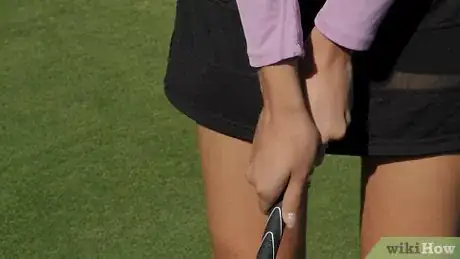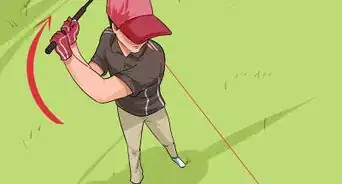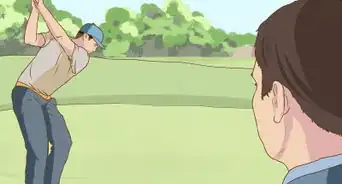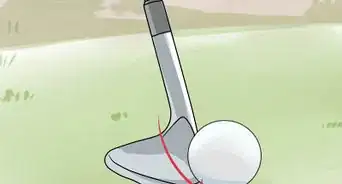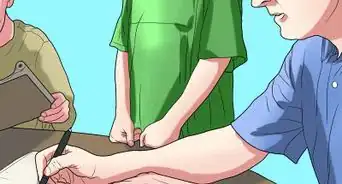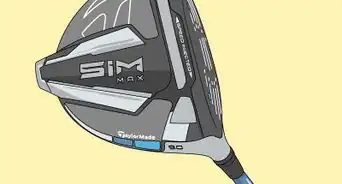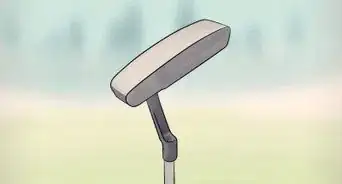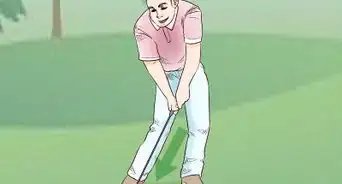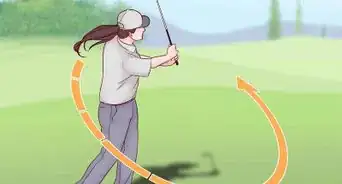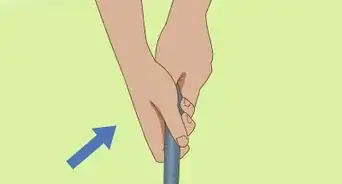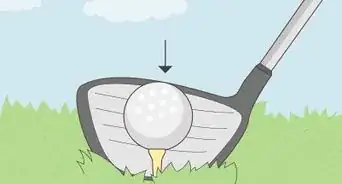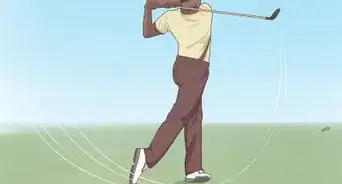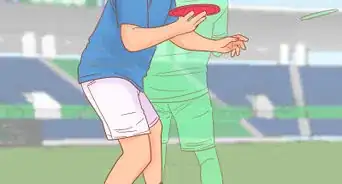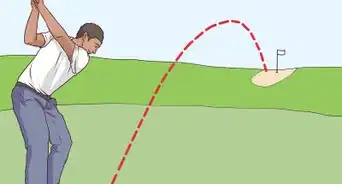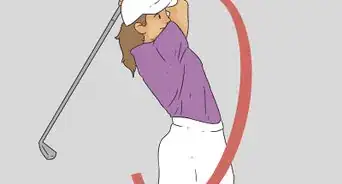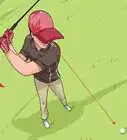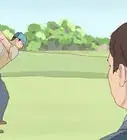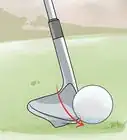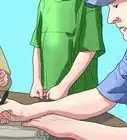This article was co-authored by Michael Metz. Michael Metz is a Golf Instructor and the Director of Instruction at Simi Hills Golf Course. With more than 15 years of experience, Michael is adept at coaching all facets of Golf. Mike uses technology, such as Flightscope, V1 Swing Suite, Blast Motion, and BodiTrak pressure mapping, to provide advanced golf training with quick results.
wikiHow marks an article as reader-approved once it receives enough positive feedback. In this case, 100% of readers who voted found the article helpful, earning it our reader-approved status.
This article has been viewed 383,947 times.
There are several ways to hold a golf club, but the technique you choose should be the one that feels comfortable to you. Any of these fundamentally sound grips will help you to hit the ball straight and maximize your distance, or increase precision on your short game. A proper grip is one of the most important aspects of having a successful game. Find the grip that works best for you and begin building on your skill.
Things You Should Know
- Place your dominant hand lower on the club with your nondominant hand on the opposite side.
- You can tuck your hands against one another or interlock your fingers depending on what’s more comfortable for you.
- For a simpler grip, try holding the club straight up in the air and gripping it like a baseball bat.
Steps
Mastering Grip Basics
-
1Place your dominant hand on the club. If you’re right-handed, this is your right hand, and vice-versa if you’re left-handed. Grab the shaft where it connects to the grip and lift the club up at a 45-degree angle. Golf Teacher Michael Metz emphasizes that the specifics of the grip may be slightly different depending on your body, but "all things being equal, the proper way to hold the club would be with the face looking at the target."[1]
- This isn’t where you will ultimately hold the club with your dominant hand, but it allows you to properly grip the club with your off hand first.
-
2Place the club in your non-dominant hand. This is your left hand if you’re right-handed, and vice-versa if you’re left-handed. Keeping your off hand relaxed and with the palm facing you, lay the grip of the club across the inside of your fingers in the area where your first knuckles and palm meet.
- The butt of the club should be extending just past the base joint of your pinkie.
Advertisement -
3Secure your off hand. Curl the bottom three fingers of your non-dominant hand around the grip. Set your thumb flat across the club. You want to roll your thumb over towards the opposite side of the grip, while curling your forefinger around the grip. According to Golf Teacher Michael Metz, "you want to see the index finger knuckle and middle finger knuckle of your left hand when you hold the club."[2]
- If you have secured your grip properly, you should feel every part on the underside of your bottom three fingers making contact with the club’s grip.[3]
- You’ll know you have a proper grip when you can feel the base, fatty part of your thumb on the handle, and not overlayed on your forefinger.
-
4Place your dominant hand. Imagine a clock with the club head pointing at twelve. Curl your fingers over the grip like you did with your other hand. According to Golf Teacher Michael Metz, "you interlock your pinky of the right hand and index finger of your left."[4] In other words, wrap your pinky finger into the space between the forefinger and middle finger of your non-dominant hand. Point your right thumb toward eleven on your imagined clock, and lay it flat on the grip of the club.[5]
- You can also interlock your pinky finger with your forefinger and middle finger if that feels more comfortable or natural to you.
Using Different Grips
-
1Try the 10-finger (or baseball) grip. To achieve this grip, simply scoot your dominant hand down the grip of the club so that there is no space between the fingers of your two hands. Instead of interlocking or overlaying your pinky finger, you grip the club like a baseball bat.[6]
- This grip is often used by novices, players with small hands, and players with arthritis.
- The baseball grip can also give you more leverage which can allow you to hit the ball farther.
- Note that with this grip you may not get as accurate a shot.
- Keep in mind to lead with your hips when swinging and follow with your hands.
-
2Try the Vardon grip. To achieve the Vardon grip, take the pinkie finger of your dominant hand and move it back to lay on top of the fingers of your left hand. It should sit on top of the space between your index and middle fingers.
- The Vardon grip is the most common and is the traditional textbook grip.
- It is especially recommended for people with large hands, and can be more comfortable for those players than the interlocking grip.
- Players with small hands may find it difficult.
-
3Try the interlocking grip. According to Golf Teacher Michael Metz, the goal of this grip is "to see that when you're gripping that club that [the line that's made when you put your right thumb and index finger together] points at your right shoulder. [That] makes for what's considered a neutral to strong grip." [7] To achieve the interlocking grip, separate the index and middle fingers of your non-dominant hand. Move the pinkie of your dominant hand into this space so that your two hands interlock.
- This grip is often recommended for younger or weaker players, but is also used by many golfing greats like Tiger Woods. It works best for players with medium or average hands.
- The interlocking grip reduces tension and excess wrist movement, but some players find it uncomfortable.
Playing with Grip Strength for Different Shots
-
1Experiment with strong and weak grips. A weak grip means the hands are rotated on the club handle more towards your target. If you can only see the knuckle of your forefinger on your dominant hand, you have a weak grip. A strong grip means the exact opposite, with a rotation to the side of your club further away from your target.[8]
- A weak grip can combat a hook as well as add height and backspin to the ball. It can also cause the ball to slice, and make proper swinging form difficult to achieve.
- A strong grip can be very comfortable and result in good low hits, but it can also make the golfer prone to hooking.
-
2Weaken your grip for short game. A looser grip will allow you to gain more precision and loose distance, which you don’t need here. Grip the club as you normally would, and pay attention to where the creases created by your forefingers and thumbs are pointing. These creases should be pointing to the left of your chin, closer to your target.
- If you are right-handed, the creases should be pointing to the left of your chin.
- If you are left-handed, the creases should be pointing to the right of your chin.
- The creases, may also make “V” shapes. You want the point of the “V” pointing closer to your target on your short game.
-
3Angle your wrists down for putting. When you’re on the green you want to minimize the movement in your wrists. Move the handle of your putter back in your dominant hand so it rests on the lifeline of your palm. Grip it the same way with your other hand. Then, angle your wrists downwards.[9]
- Hold your putter with a baseball grip. You don’t need or want wrist movement here. Holding your putter with a 10 finger grip and angling your wrists down helps to keep them locked.
- Your putter should be an extension of your arms and swing like a pendulum.
Community Q&A
-
QuestionI am 60 years old and rather small and want to try golfing. I am going to the driving range and have small hands. What grip is best for me?
 Community AnswerUse a baseball grip with small hands. Keep it simple, at 60 use a tee for all shots until you develop a ball flight, shoulder turn, and comfortable grip. Do not get caught up in methodology, at 60 your body tolerance for a golf swing is a limited shoulder and hip turn. Solid hand/eye coordination and feel are the most important.
Community AnswerUse a baseball grip with small hands. Keep it simple, at 60 use a tee for all shots until you develop a ball flight, shoulder turn, and comfortable grip. Do not get caught up in methodology, at 60 your body tolerance for a golf swing is a limited shoulder and hip turn. Solid hand/eye coordination and feel are the most important. -
QuestionHow do I stop slicing the ball when golfing?
 Community AnswerRest the club head square behind the ball, then loosen and reapply your grip, and you will hit the ball on line. Be aware that if you wear glasses, bifocals and transition eyeglass lenses distort lines. Letting your wrists roll before ball contact will change the angle the club head hits the ball, resulting in a hook or slice. There is a YouTube video on how to hook and slice purposely to get around trees, that illustrates what happens when the club face is set-off square.
Community AnswerRest the club head square behind the ball, then loosen and reapply your grip, and you will hit the ball on line. Be aware that if you wear glasses, bifocals and transition eyeglass lenses distort lines. Letting your wrists roll before ball contact will change the angle the club head hits the ball, resulting in a hook or slice. There is a YouTube video on how to hook and slice purposely to get around trees, that illustrates what happens when the club face is set-off square.
References
- ↑ Michael Metz. Golf Instructor. Expert Interview. 24 February 2022.
- ↑ Michael Metz. Golf Instructor. Expert Interview. 24 February 2022.
- ↑ http://golftips.golfsmith.com/correct-way-grip-golf-club-1528.html
- ↑ Michael Metz. Golf Instructor. Expert Interview. 24 February 2022.
- ↑ http://golftips.golfsmith.com/correct-way-grip-golf-club-1528.html
- ↑ http://www.golfchannel.com/media/school-golf-change-your-grip-more-distance/
- ↑ Michael Metz. Golf Instructor. Expert Interview. 24 February 2022.
- ↑ http://golf-info-guide.com/golf-tips/playing-conditions/pros-and-cons-of-every-golf-grip-style/
- ↑ http://www.golf.com/instruction/dave-pelzs-putting-tips
About This Article
To hold a golf club, start by placing your dominant hand on the shaft of the club where it connects to the grip. Then, lift the club at a 45 degree angle and place your other hand palm-up beneath the grip. Wrap your bottom three fingers around it and set your thumb across the top of the grip. Next, curl the fingers of your dominant hand around the grip so that your pinky is in the space between your non-dominant forefinger and middle finger. Finally, lay your dominant thumb flat on the grip of the club. For tips on how use an interlocking grip to reduce wrist movement, read on!

